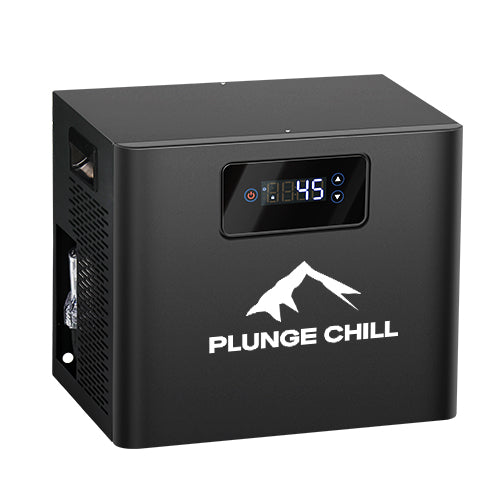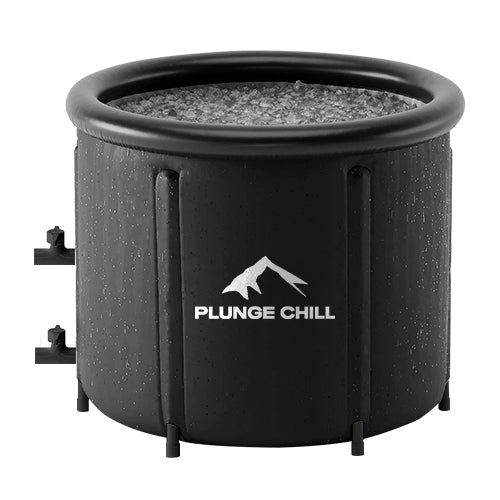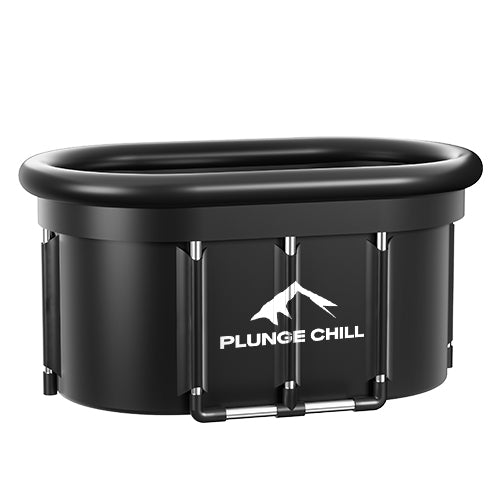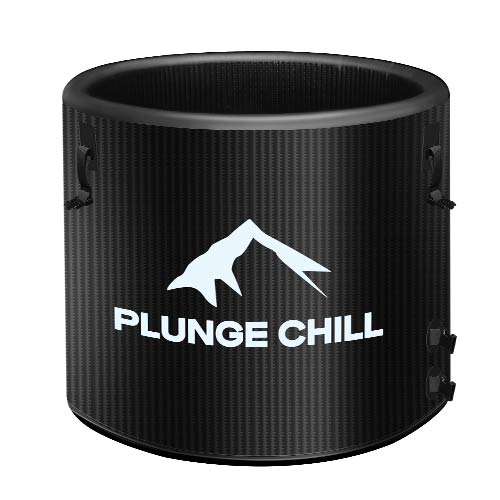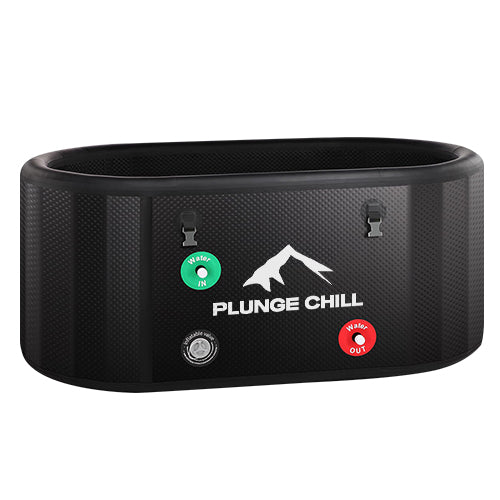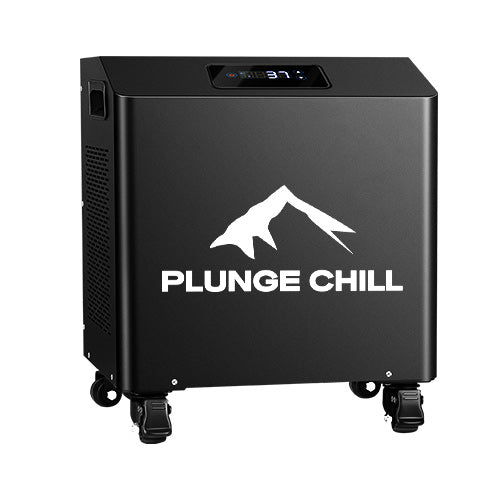You've probably seen those videos of Lewis Hamilton sitting in an ice tub, looking cool and completely relaxed. And in F1: DRIVEN TO THE EDGE, Brad Pitt's character does the same thing—emerges from an ice bath, preparing for the next round of racing.
These tell us that elite athlete do use ice plunge to help their body recovery and enhance performance. When your racing environment can reach 140°F and you're about to lose 6-9 pounds of sweat in two hours, this recovery method is just necessary.

But the question is: do ice baths actually work? Or do they just look cool?
Physiological Basis of Ice Baths
What happens to your body
The moment you jump into ice water, your blood vessels constrict immediately. Sounds painful, but this process actually helps clear the "junk" from your muscles: lactic acid, inflammatory byproducts, all the stuff that makes you sore.
It's like squeezing a sponge. First compress, then release, and the dirty stuff gets squeezed out.
Mayo Clinic research confirms this: cold therapy genuinely reduces pain and soreness after training. The principle is simple: low temperatures slow your metabolism, giving your recovery systems time to work.
Why muscle soreness decreases
There's an interesting rugby team experiment. 16 players, after matches half of them soaked in ice water (50°F, 5 minutes, twice), the other half rested normally.
Result? The ice bath group was significantly less sore the next day.
This wasn't just one study. Scientists reviewed 52 related studies and found the same result: ice baths beat simply resting when it comes to reducing delayed onset muscle soreness.
The reason is that cold water directly "shuts off" the inflammatory response in muscles while providing immediate numbing effects. When you warm back up, fresh blood flows back into muscles carrying nutrients.
Your brain reacts too
Ice water also triggers your brain to release endorphins, those feel-good chemicals that runners talk about when they mention their "high."
A study of 33 people showed: after 5-minute ice water immersion, they felt more alert and less anxious. This makes sense: if you can survive voluntarily freezing yourself, daily stress doesn't seem so bad.
Charles Leclerc explains it simply: "So once we get into the car, it's extremely warm. You sweat a lot, but if you do the cold bath before, it helps you feel much better inside the car."
Just that simple.

Athlete-Specific Protocols
Now here's the key: when to use it, how to use it?
Timing determines effectiveness
Pre-competition ice baths: Research shows that lowering core body temperature 20 minutes before competing improves performance in hot environments. F1 drivers use this technique to handle cockpit temperatures that can reach 140°F, and other athletes can use it for hot competition environments.
Post-training ice baths: The best time is right after intense training, during that window when the inflammatory response is just beginning.
Back-to-back competitions: When recovery time is less than 24 hours during tournaments, ice baths show the most obvious effects.
Temperature and timing aren't random
| Experience Level | Recommended Water Temperature (°F) | Duration per Session | Frequency per Week |
| Beginner | 53–59°F | 1–2 minutes | 2–3 times |
| Intermediate | 45–52°F | 3–5 minutes | 3–5 times |
| Advanced | 39–43°F | 5–10 minutes (max 15 min) | 4–7 times |
Temperature requirements:
- 50-59°F is the optimal range
- Most effective research used 50°F
- Below 39°F: Advanced users only - increased cold injury risk
Time control:
- Standard: 5-10 minutes
- Advanced: Two 5-minute sessions with 2.5-minute break
- Beginners: start with 1-2 minutes
- Absolute limit: 15 minutes
Frequency needs to be reasonable
- Competition phase: 2-3 times per week during high-intensity training blocks
- In-season: after competitions or toughest training sessions
- Off-season: reduce frequency to allow natural adaptation
Important reminder: If you're specifically training for strength or muscle building, daily ice baths might interfere with training effects.
Professional Implementation Guide
Equipment choices: from entry-level to professional
Entry-level (under $100)
Large container + ice (40-90 pounds each time) + thermometer. Perfect for testing whether you can stick to this habit.
Mid-range portable (~$100-$600)
For users seeking more consistent experiences, portable ice bath tubs offer better solutions. For example:
-
Product A ($89-$299):
- Nylon fabric with sub-zero insulation technology
- Weight: 8 lbs empty, highly portable
- Uses ice for temperature control
- Cold retention: 24 hours to multiple days (climate dependent)
-
Product B ($499):
- Portable ice bath with optional chiller compatibility
- Filter replacement maintenance system
- 40 lbs weight, fits users up to 6'9"
- Requires separate chiller purchase for electric cooling
This kind of solution provides good entry points into regular cold therapy practice. While more convenient than DIY solutions, the ongoing ice costs and unstable temperature control lead many users to seek better alternatives.

Professional temperature control (~$500-$2000)
This is where Plunge Chill systems truly excel. Unlike traditional solutions requiring continuous ice purchases, Plunge Chill provides precise temperature control systems:
-
1/3HP Chiller ($499): Precisely controls down to 42°F, especially suitable for beginners to gradually adapt
- 600W compressor, whisper-quiet operation (39-45 dB)
- Built-in pump and filtration system
- Cools 66 gallons: 80°F to 50°F in 8-10 hours
- Compact design: 35 lbs, plug-and-play setup
- Energy cost: $0.80-$1.50/day (20x cheaper than ice)
-
1HP Chiller ($1,299): Reaches extreme low temperatures of 36°F, meeting professional athlete requirements
- 2600W compressor, handles up to 110 gallons
- Cools 80°F to 40°F in 8 hours
- Commercial-grade titanium coil, 1-micron filtration
- Weather-tested casing, caster wheels for mobility
- LED display with safety shutoffs
- Cools water down to 36°F
- Plug-and-plunge setup, no plumbing required
Actually, the price of Plunge Chill products ranges from $100 to $2000. For the same price, you can get better quality, and for the same quality, you get the product with lower price.
So if you're looking for a high-performance yet affordable ice bath system, consider Plunge Chill's.
As a user evaluated: "This is the best tub I've used under $1K. I've done all the DIY stuff—trash cans, barrels—you name it. This one is next level. The oval layout lets me fully immerse and sit more naturally. The PVC is soft but strong, and it insulates well."
Top-tier professional (~$2,000-$10,000)
High-end professional cooling equipment provides the most advanced ice bath experiences:
-
Product C ($8,990): Premium all-in-one design with smart temperature control system
- 1HP chiller with 37°F cooling capability
- 10 integrated sensors with smartphone control
- Cooling rate: 10-12°F per hour
- Dual filtration system with electronic control valve
- Plug-and-plunge setup, no plumbing required
- Other professional brands ($3,000-$6,000): Feature robust construction, advanced filtration systems, and commercial-grade components
These systems offer top-of-the-line performance and are ideal for facilities with high usage demands. But for most people, these are expensive.
For those with smaller budgets, you can choose brands like Plunge Chill which offers an excellent cost-effective alternative, while maintaining professional-grade performance.
Specific operation process
Preparation: Monitor water temperature precisely, prepare towels and warm clothing. Must have someone nearby for initial attempts.
Entry technique: Enter slowly to avoid cold shock. Immerse to neck level for maximum contact area. Control breathing, don't hyperventilate. Watch for adverse reactions, like excessive shivering, confusion, etc.
Exit and recovery: Exit slowly, allow natural rewarming. Don't immediately take hot showers, which can cause dramatic blood pressure changes.
Safety first
Athletes with cardiovascular disease, Raynaud's disease, or circulation disorders need medical clearance.
Signals to stop immediately:
- Uncontrollable shivering
- Confusion or disorientation
- Loss of coordination
- Abnormal skin color changes
Never exceed 15 minutes. Hypothermia risk increases dramatically after this point.
Alternative Cold Therapies
If ice baths aren't right for you, there are other options:
Contrast water therapy: Hot water (98-109°F) and cold water (54-59°F) alternating, typically 3:1 or 4:1 hot to cold ratio. May enhance circulation effects.
Cold showers: Easier to implement. A study of 3,018 people showed that adding 30-90 seconds of cold water to showers reduced sick days by 29%.
Whole-body cryotherapy: -166 to -220°F air exposure for 2-3 minutes. Similar physiological response to water immersion, but requires specialized facilities.
The Key is Strategic Use
Ice baths aren't a cure-all, but they're effective in specific situations:
Limited recovery time during competition periods, hot environment adaptation, high-intensity training phases, situations requiring rapid recovery.
Remember the fundamentals are always most important: Sleep, nutrition, and hydration need to be handled first. Ice baths are the bonus points built on these foundations, and choosing reliable equipment like Plunge Chill ensures you get consistent recovery effects.
Use strategically, not habitually. Pay attention to individual responses: some athletes respond better than others. Avoid use during specific adaptation phases (strength building periods, heat adaptation periods).
The Verdict: Is a Cold Plunge Worth It?
Research supports targeted use of ice baths for soreness reduction and competition preparation. Like any tool, effectiveness depends on proper application and timing within your overall training plan.
If you want a budget-friendly option that delivers professional results, consider Plunge Chill, which offers precise temperature control without the premium price tag.
Next time you see Hamilton looking so calm in that ice water, you'll know he's not just showing off...he's preparing for every detail that might determine victory or defeat.
